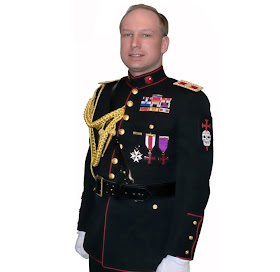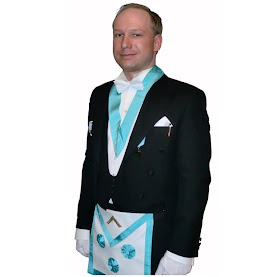

Added: July 25, 2011
http://en.wikipedia.org/wiki/Anders_Behring_Breivik#cite_note-manifesto-2
excerpts
PCCTS, "Knights Templar" order
During interrogation, Breivik claimed membership in an "international Christian military order" that "fights" against "Islamic suppression". This order allegedly is called the "Knights Templar" and, according to his manifesto, has between fifteen and eighty "ordinated knights" besides an unknown number of "civilian members".[73]
The order, whose full name is the "Pauperes commilitones Christi Templique Solomonici" or PCCTS, is said to have been established in London in April, 2002, as a "re-founding" of the twelfth-century crusading order. The new organisation supposedly was established to take political and military control of Western Europe, with its members being armed as an "anti-Jihad crusader-organisation". It reportedly was established by nine men: two Englishmen, a Frenchman, a German, a Dutchman, a Greek, a Russian, a Norwegian, and a Serb. The main initiator apparently was the Serb, whom Breivik claims to have visited in Liberia and whom he referred to as a "war hero".
Breivik said that his own code name was "Sigurd Jorsalfar" (recalling the twelfth-century King Sigurd I of Norway, himself a Crusader) and that his "mentor" was "Richard Lionheart". Breivik asserted that Norway had "4,848 traitors" who had to die.[3]
In his manifesto, Breivik wrote that "[t]he PCCTS, Knights Templar is . . . . not a religious organization but rather a Christian 'culturalist' military order."[4]
Religion
On his Facebook profile, Breivik describes himself as a Christian.[45] Breivik states that he chose to be baptised into the Church of Norway at the age of 15 although he later became disenchanted with Norway's State Church.[74] In his manifesto, he described himself as a "moderately religious" protestant (p. 1398) who supports "a reformation of Protestantism leading to it being absorbed by Catholisism [sic]". Elsewhere in his manifesto, Breivik also declared himself to be the "a savior of our people and of European Christendom" (p. 1435).[4]
Police reports describe Breivik as a "Christian fundamentalist".[9][75] However, in contrast to the common theological understanding of such in the American sense, that of "militantly anti-modernist Protestant evangelicalism," and its emphasis on Protestant doctrine and salvation by faith,[76] in his manifesto Breivik referred to "Protestantism as the Marxism of Christianity," (p. 1346) and criticized salvation by faith and deplored "Christian fundamentalist theocracy" as "everything we do not want", in favor of "a secular European society based on our Christian cultural heritage", (p. 1346) while he also commended the separation of Church and state. (p. 1132)
Breivik invoked Roman Catholic Canon Law and the example of the Crusades for support, and looked toward a "Crusader Pope." (p. 1135) He also believed those who died in his case were worthy of an Indulgence, (pp. 1324-26, 46) and stated, "If there is a God I will be allowed to enter heaven as all other martyrs for the Church in the past," (p. 1345) and advocated that such potential martyrs take of "the Eucharist (Holy Communion/The Lord's Supper)" for strength to face such death. (p. 1345)
Breivik condemns Pope Benedict XVI, however, for his dialogue with Islam: “Pope Benedict has abandoned Christianity and all Christian Europeans and is to be considered a cowardly, incompetent, corrupt and illegitimate Pope.” It will thus be necessary, writes Breivik, to overthrow the Protestant and Catholic hierarchies, after which a “Great Christian Congress” would set up a new European Church.[77]
Breivik also considered it sufficient that one be "a Christian-agnostic or a Christian atheist" to fight for his Christian cultural heritage, (p. 1361, 62) and held that "it is essential that science takes an undisputed precedence over biblical teachings." (p. 1403)
In an insight on his personal morality, Breivik liked the clubs in Hungary, but avoided affairs with females for the sake of his mission, though he enjoyed getting drunk at his birthday party. (p. 1415) He also enjoyed video games such as "World of Warcraft' and "Dragon Age Origins," and stated "I regret to admit that I’ve become a notorious downloader of pirated movies, series and games etc." (p. 1418)...
Breivik listed Freemasonry as one of his interests on his Facebook page and was himself a Freemason.[24] He had displayed photographs of himself in Masonic regalia on his Facebook profile[25] and was a member of St. Olaus T.D. Tre Søiler No. 8 in Oslo.[26] In interviews after the attacks, his lodge stated they had only minimal contact with him, and Grand Master of the Norwegian Order of Freemasons Ivar A. Skaar issued an edict immediately expelling him from the fraternity based upon the acts he carried out and the values that appear to have motivated them.[27][28] His manifesto called for a revolution to be led by Knights Templar.[29]

















































